Enhancing Al-Cu-Si Alloy Performance: How Copper and Silicon Additions Boost Strength and Machinability
This technical summary is based on the academic paper "Analysis of the Microstructure, Properties and Machinability of Al-Cu-Si Alloys" by J. Kozana, M. Piękoś, M. Maj, A. Garbacz-Klempka*, P.L. Żak, published in ARCHIVES of FOUNDRY ENGINEERING (2020).
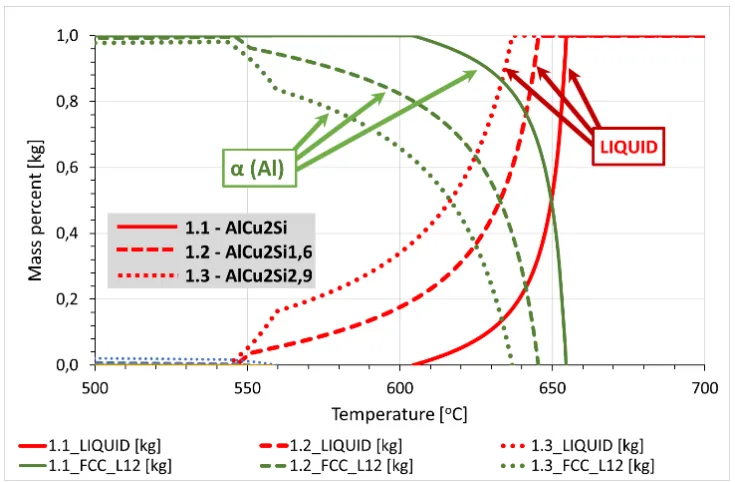
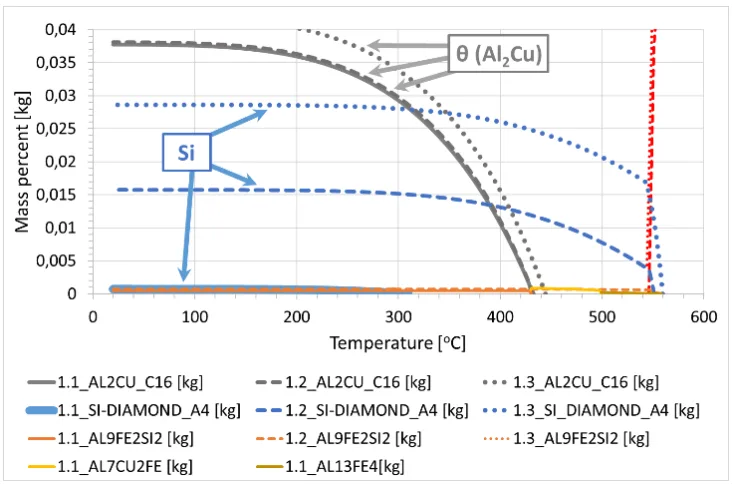
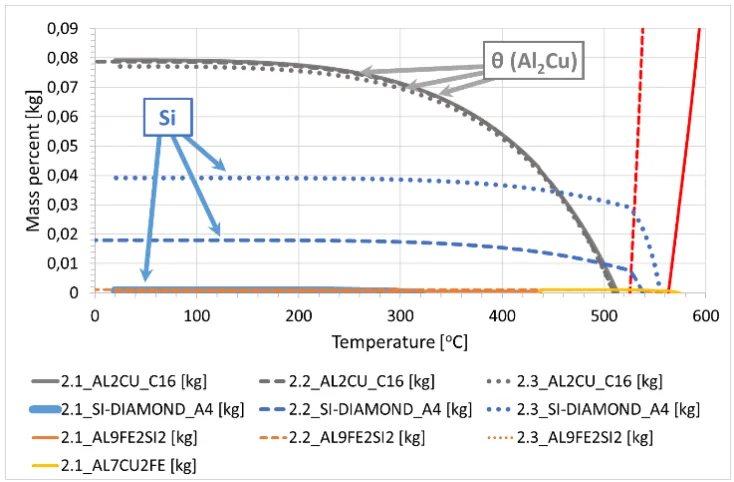
Keywords
- Primary Keyword: Al-Cu-Si alloy
- Secondary Keywords: Aluminum Alloys, Mechanical Properties, Microstructure, Machinability, Casting, Thermo-Calc
Executive Summary
- The Challenge: The ongoing need to enhance the mechanical strength, hardness, and machinability of aluminum alloys to meet the demanding requirements of the automotive and aerospace industries.
- The Method: A systematic study was conducted by creating Al-Cu-Si alloys with constant copper levels (2% and 4%) and variable silicon content, followed by comprehensive analysis of their microstructure, mechanical properties, and machinability.
- The Key Breakthrough: The research quantifies how specific additions of copper and silicon significantly increase strength and hardness through solution and precipitation hardening, while also improving wear resistance and machinability.
- The Bottom Line: For casting professionals, precise control over copper and silicon content provides a direct and predictable method for engineering Al-Cu-Si alloys with superior strength, hardness, and machining characteristics.
The Challenge: Why This Research Matters for HPDC Professionals
In modern manufacturing, particularly in the automotive, aviation, and transport sectors, aluminum alloys are indispensable. Their low density, good corrosion resistance, and excellent castability make them a top choice. However, the challenge lies in continuously improving their mechanical performance—specifically strength and hardness—without compromising other critical properties.
Engineers and metallurgists are constantly seeking ways to enhance these materials through optimized chemical compositions, refining processes, and heat treatments. This research addresses a key area of interest: the ternary Al-Cu-Si system. While Al-Si alloys are known for castability and Al-Cu alloys for strength, combining them offers a promising route to lightweight components that are both strong and corrosion-resistant. This study provides critical data on how to effectively balance these elements to achieve a superior final product.
The Approach: Unpacking the Methodology
The research team employed a rigorous, multi-faceted approach to ensure the reliability and depth of their findings. This methodology combined theoretical modeling with extensive physical testing.
Method 1: Alloy Formulation and Casting
The study was conducted in two main stages. In the first stage, alloys were prepared with a constant copper content of 2% and variable silicon content (0.5%, 1.5%, and 3%). In the second stage, the copper content was increased to 4%, with silicon added in amounts of 0.1%, 2%, and 4%. High-purity electrolytic aluminum, crystalline silicon, and electrolytic copper were melted in a medium-frequency induction furnace. The melts were cast into metal molds with a controlled pouring temperature of 730-750°C and a mold temperature of 150-170°C.
Method 2: Thermodynamic and Microstructural Analysis
To understand the theoretical behavior of the alloys, the researchers used the CALPHAD (CALculation of PHAse Diagrams) method with Thermo-Calc software. This modeling predicted the crystallization characteristics and phase compositions. The actual microstructure of the cast samples was then examined using light microscopy (LM) after etching, allowing for a direct comparison between theoretical predictions and real-world results.
Method 3: Mechanical Property and Machinability Testing
A comprehensive suite of tests was performed to quantify the alloys' performance:
- Tensile Strength (UTS) and Elongation (E): Measured using an INSTRON device to assess strength and ductility.
- Hardness: Evaluated using both the Brinell method (BHN) for bulk hardness and the Vickers-Hanemann method for microhardness (µHV) of specific structural phases.
- Machinability: Assessed using the Keep-Bauer method, which involves drilling a hole with a constant feed force. The drilling depth over time and the characteristics of the chips produced were analyzed to determine machinability and wear resistance.
The Breakthrough: Key Findings & Data
The study yielded clear, actionable data on the relationship between alloy composition and performance.
Finding 1: Copper and Silicon Directly Enhance Strength and Hardness
The addition of both copper and silicon resulted in a significant increase in the mechanical properties of the aluminum alloys. As shown in Table 6, alloys with a higher copper content of 4% consistently achieved greater strength and hardness than the 2% copper alloys. For instance, the alloy with 4% Cu and ~4% Si (Sample 2.3) reached a tensile strength of 182 MPa and a Brinell hardness of 68.1 HBN. This is a substantial improvement over the base alloy with 2% Cu and minimal Si (Sample 1.1), which had a UTS of 94 MPa and hardness of 37.8 HBN. This strengthening is attributed to two key mechanisms: solution hardening from silicon atoms in the aluminum matrix and precipitation hardening from the formation of the Al₂Cu intermetallic phase.
Finding 2: Improved Machinability and Wear Resistance
The machinability tests demonstrated a clear enhancement in performance for the alloyed samples. The graph in Figure 11, showing hole depth as a function of time, indicates that the Al-Cu-Si alloys possess superior machinability compared to pure aluminum and are competitive with the reference AlMg10 alloy, which is known for being machinable. The hardening effect of the copper and silicon additions is directly linked to this improved wear resistance. The images of chips produced during drilling (Figure 12) further confirm this, showing that the alloyed materials behave more favorably during cutting operations.
Practical Implications for R&D and Operations
- For Process Engineers: This study suggests that adjusting the copper and silicon content in the melt is a direct lever for controlling the final mechanical properties and machinability of cast components, allowing for precise tailoring to application-specific requirements.
- For Quality Control Teams: The data in Table 6 and the microstructures in Figures 5-9 illustrate the direct correlation between alloy composition, the presence of specific phases (like Al₂Cu), and resulting hardness. This can inform new quality inspection criteria, such as using microhardness testing to validate material integrity.
- For Design Engineers: The findings indicate a clear trade-off between strength and ductility (elongation). While 4% copper alloys are stronger, they exhibit lower elongation (max 7.6%) compared to 2% copper alloys (max 16.5%). This is a critical consideration in the early design phase when balancing strength requirements with the need for material toughness.
Paper Details
Analysis of the Microstructure, Properties and Machinability of Al-Cu-Si Alloys
1. Overview:
- Title: Analysis of the Microstructure, Properties and Machinability of Al-Cu-Si Alloys
- Author: J. Kozana, M. Piękoś, M. Maj, A. Garbacz-Klempka*, P.L. Żak
- Year of publication: 2020
- Journal/academic society of publication: ARCHIVES of FOUNDRY ENGINEERING
- Keywords: Casting, Aluminum Alloys, Ternary Al-Cu-Si alloy, Mechanical Properties, Microstructure, Thermo-Calc
2. Abstract:
As part of the studies conducted in the field of broadly understood casting of non-ferrous metals, selected results on the impact of variable additions of copper and silicon in aluminium were presented. A series of melts was carried out with copper content kept constant at a level of 2% (1st stage) and 4% (2nd stage) and variable contents of silicon introduced into aluminium. The crystallization characteristics of the examined alloys and the percentage of structural constituents at ambient temperature were obtained by modelling the thermodynamic parameters of individual phases with the CALPHAD method. The microstructure of the obtained alloys was examined and microhardness was measured by the Vickers-Hanemann method. The alloy properties were assessed based on the results of mechanical tests, including ultimate tensile strength (UTS), hardness (BHN) and elongation (E). The machinability of the tested alloys was analyzed in a machinability test carried out by the Keep-Bauer method, which consisted in drilling with a constant feed force. The obtained results clearly indicate changes in the images of microstructure, such as the reduction in grain size, solution hardening and precipitation hardening. The changes in the microstructure are also reflected in the results of mechanical properties testing, causing an increase in strength and hardness, and plasticity variations in the range of 4 ÷ 16%, mainly due to the introduced additions of copper and silicon. The process of alloy strengthening is also visible in the results of machinability tests. The plotted curves showing the depth of the hole as a function of time and the images of chips produced during the test indicate an improvement in the wear resistance obtained for the tested group of aluminium alloys with the additions of copper and silicon.
3. Introduction:
Non-ferrous metals and alloys are critical in modern technology, particularly aluminum alloys, which are widely used in industries such as electrical engineering, automotive, aviation, and construction. Due to their excellent mechanical properties, castability, low density, and good corrosion resistance, they are a subject of continuous improvement. Efforts to enhance their usability involve optimizing chemical composition, refining processes, casting technology, and heat treatment. Ternary alloys from the Al-Cu-Si system are gaining popularity as they are lightweight and offer superior strength compared to Al-Si alloys and better corrosion resistance than Al-Cu alloys, making them increasingly relevant for automotive and aviation applications.
4. Summary of the study:
Background of the research topic:
The study is situated within the field of non-ferrous metal casting, focusing on the development of aluminum alloys with enhanced properties for industrial use.
Status of previous research:
Previous work has focused on improving aluminum alloys through various means, including alloying. Al-Si and Al-Cu alloys are well-studied, but the ternary Al-Cu-Si system is an area of growing interest due to its potential to combine the beneficial characteristics of both binary systems.
Purpose of the study:
The aim was to analyze the influence of variable silicon additions on the properties of an Al-Cu alloy, where copper content was held constant at two different levels (2% and 4%). The study focused on the resulting microstructure, mechanical properties, and machinability of samples cast into metal molds.
Core study:
The research involved a two-stage experimental plan. In stage one, aluminum alloys with 2% copper and variable silicon (0.5%, 1.5%, 3%) were produced. In stage two, alloys with 4% copper and variable silicon (0.1%, 2%, 4%) were created. The study combined thermodynamic modeling (CALPHAD) with empirical testing, including chemical analysis, microstructural examination, mechanical property assessment (UTS, elongation, hardness, microhardness), and a machinability test using the Keep-Bauer method.
5. Research Methodology
Research Design:
The study employed a comparative experimental design across two stages, systematically varying the silicon content while keeping the copper content constant within each stage (2% Cu in Stage 1, 4% Cu in Stage 2).
Data Collection and Analysis Methods:
- Alloy Preparation: Melts were prepared in a medium frequency induction furnace using electrolytic aluminum A199.99, crystalline silicon, and cathode electrolytic copper. A primary AlCu50 master alloy was used. Pouring temperature was controlled at 730-750°C into a metal mold heated to 150-170°C.
- Chemical Composition Analysis: A SPECTROMAXx emission spectrometer was used to verify the chemical composition of the cast samples.
- Thermodynamic Modeling: The CALPHAD method was implemented using the Thermo-Calc software package with the TCS Al-based Alloys Database to simulate equilibrium crystallization.
- Microstructural Characterization: Samples were examined by light microscopy (Eclipse LV 150) after etching with a 10% aqueous NaOH solution.
- Mechanical Testing: Ultimate tensile strength (UTS) and elongation (E) were measured on an INSTRON model 1115 device. Hardness was measured by the Brinell method (BHN). Microhardness (µHV) was tested using the Vickers-Hanemann method.
- Machinability Analysis: The Keep-Bauer method was used, which involved drilling a 6 mm diameter hole with a constant feed force and measuring the drilling depth over time.
Research Topics and Scope:
The research scope was limited to the analysis of as-cast Al-Cu-Si alloys with specific compositions. The study investigated the relationships between chemical composition, thermodynamic behavior, microstructure, mechanical properties (strength, hardness, ductility), and machinability.
6. Key Results:
Key Results:
- Thermodynamic Modeling: CALPHAD analysis predicted the formation of four primary phases at ambient temperature: α(Al) solid solution (FCC_L12), θ(Al₂Cu) intermetallic (AL2CU_C16), primary Silicon (SI-DIAMOND_A4), and an iron-bearing impurity phase (AL9FE2SI2). Increasing copper and silicon content lowered the liquidus temperature.
- Microstructure: Microstructural analysis confirmed the presence of a dominant α-Al matrix with precipitates of the Al₂Cu phase and, with increasing silicon content, characteristic silicon crystallites. The Al₂Cu phase was observed with a favorable dispersion distribution.
- Mechanical Properties: Alloys with 4% Cu exhibited higher tensile strength and hardness compared to alloys with 2% Cu. For example, UTS increased from 136 MPa to 182 MPa in the 4% Cu series as silicon increased. Hardness also increased with both copper and silicon additions. Elongation showed variability, reaching a maximum of 16.5% in the 2% Cu series and 7.6% in the 4% Cu series, indicating a trade-off between strength and ductility.
- Machinability: The machinability tests demonstrated that the alloy strengthening process resulted in improved wear resistance. The Al-Cu-Si alloys showed machinability comparable to or better than a reference AlMg10 alloy and significantly better than pure aluminum.
Figure Name List:
- Fig. 1. Simulation model of alloy crystallization in the temperature range 700-500 ° C, determined for alloys 1.1-1.3.
- Fig. 2. Simulation model of alloy crystallization in the temperature range 600-200 °C (fragment of the graph of the phase content 0-0.04 % m/m), determined for alloys 1.1-1.3.
- Fig. 3. Simulation model of alloy crystallization in the temperature range 700-500 ° C, determined for alloys 2.1-2.3.
- Fig. 4. Simulation model of alloy crystallization in the temperature range 600-200 °C (fragment of the graph of the phase content 0-0.09 % m/m), determined for alloys 2.1-2.3.
- Fig. 5. Microstructure of 1.1 AlCu2Si alloy; with the data of Thermo-Calc; a) 100x; b) 500x
- Fig.6. Microstructure of 1.2 AlCu2Si1,6 alloy; with the data of Thermo-Calc; a) 100x; b) 500x
- Fig. 7. Microstructure of 2.1 AlCu4,3Si alloy; with the data of Thermo-Calc; a) 100x; b) 500x
- Fig. 8. Microstructure of 2.2 AlCu4,3Si1,8 alloy; with the data of Thermo-Calc; a) 100x; b) 500x
- Fig. 9. Microstructure of 1.3 AlCu2Si2.9 and 2.3 AlCu4,2Si4 alloy; with the data of Thermo-Calc; 100x
- Fig. 10. A comparison of the results of the strength, elongation and hardness testing
- Fig. 11. Averaged machinability results obtained for the examined samples
- Fig. 12. Comparison of the images of chips produced during machinability testing

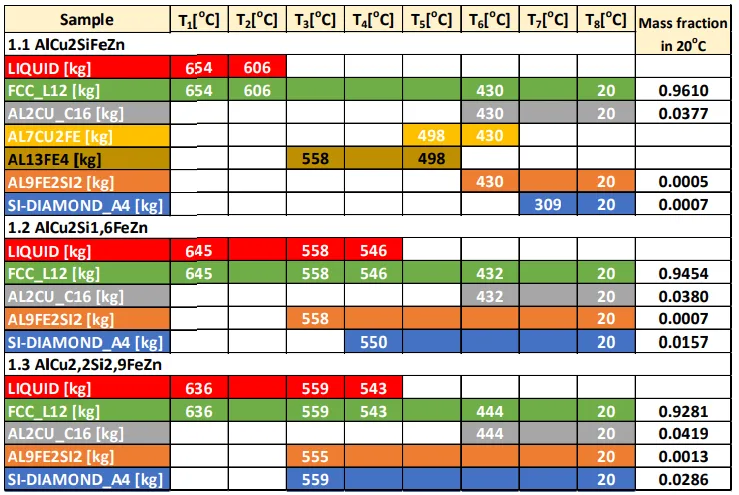
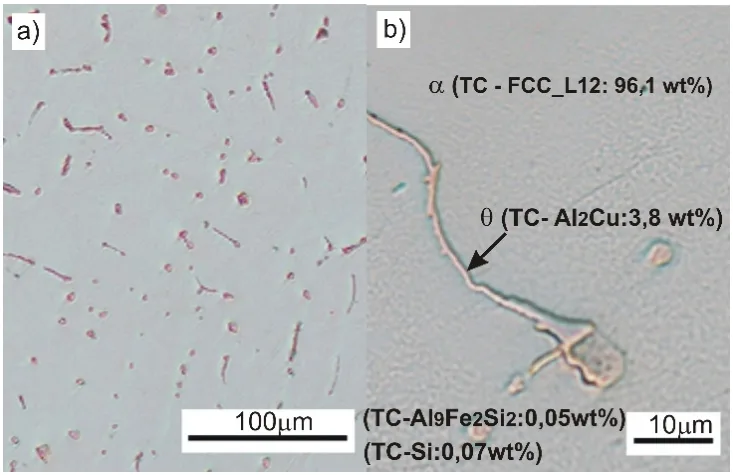
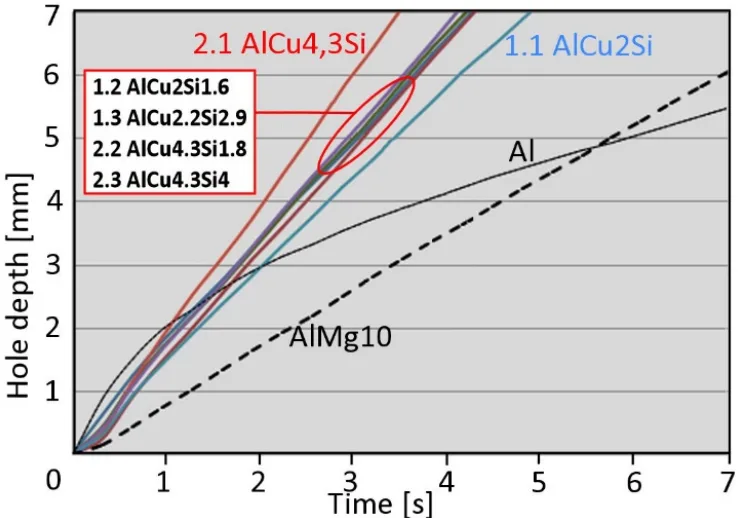
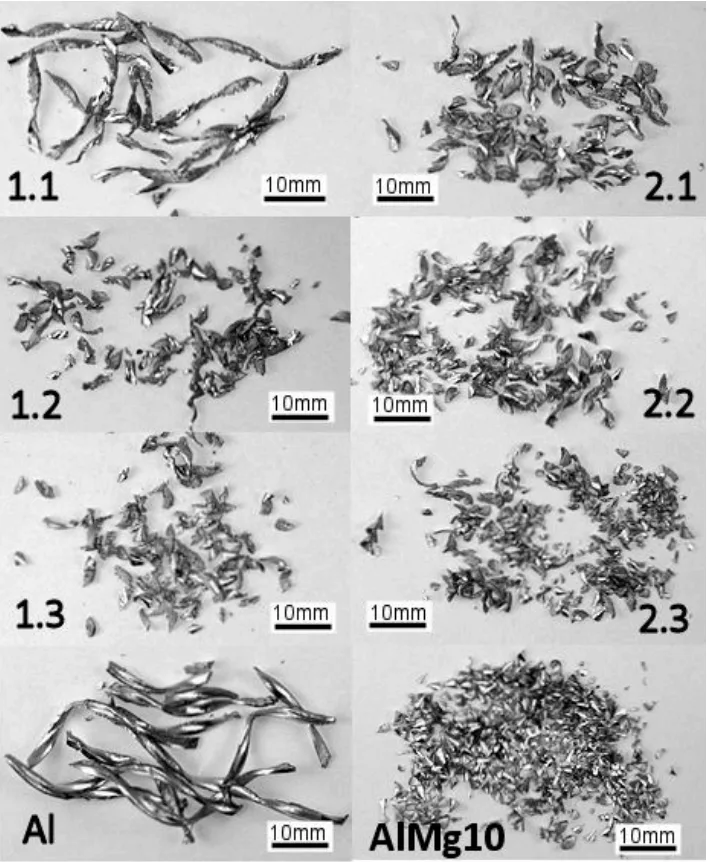
7. Conclusion:
Testing of primary aluminium alloys with variable additions of copper and silicon has shown a relatively high impact of the additives used. The results confirm changes in the microstructure, including precipitates at the grain boundaries of the solid solution of copper in aluminium. Silicon is released as primary precipitates and as an Al9Fe2Si2 compound, while copper forms the Al₂Cu intermetallic phase. The method of modelling the crystallization process accurately reflects the observed microstructures. Changes in the microstructure are clearly visible in the mechanical properties, with strength and hardness increasing due to the presence of copper and silicon, while plasticity varies. Alloys with 4% copper achieve higher tensile strength and hardness, mainly due to a higher content of Al₂Cu dispersion precipitates. The hardening of the alloy is also evident in the machinability tests, which indicate an improvement in the wear resistance of the examined aluminium alloys with the additions of copper and silicon.
8. References:
- [1] Goehler, D.D. (1988). Proc. of Innovations and Advancements in Aluminum Casting Technology-AFS Special Conf., City of Industry, CA (pp. 103–06). American Foundrymen's Society, Des Plaines, Illinois, USA.
- [2] Wang, Q.G. (2003). Microstructural effects on the tensile and fracture behavior of aluminum casting alloys A356/357. Metallurgical and Materials Transactions A: Physical Metallurgy and Materials Science. 34, 2887-2899. DOI: 10.1007/s11661-003-0189-7.
- [3] Farahany, S., Ourdjini, A., Idris, M.H. & Shabestari, S.G., (2013). Computer-aided cooling curve thermal analysis of near eutectic Al-Si-Cu-Fe alloy: Effect of silicon modifier/refiner and solidification conditions on the nucleation and growth of dendrites. Journal of Thermal Analysis and Calorimetry. 114, 705-717. DOI: 10.1007/s10973-013-3005-7.
- [4] Ghanbari, E., Saatchi, A., Lei, X., & Macdonald, D.D. (2019). Studies on Pitting Corrosion of Al-Cu-Li Alloys Part II: Breakdown Potential and Pit Initiation. Materials. 12(11), 1786. DOI: 10.3390/ma12111786.
- [5] Ghanbari, E., Saatchi, A., Lei, X., & Macdonald, D.D. (2019). Studies on Pitting Corrosion of Al-Cu-Li Alloys Part III: Passivation Kinetics of AA2098-T851 Based on the Point Defect Model. Materials. 12(12), 1912. DOI: 10.3390/ma12121912.
- [6] Rzadkosz, S., Zych, J., Piękoś, M., Kozana, J., Garbacz-Klempka, A., Kolczyk, J. & Jamrozowicz, Ł. (2015). Influence of refining treatments on the properties of Al-Si alloys. Metalurgija. 54(1), 35-38. http://hrcak.srce.hr/file/187164.
- [7] Kozana, J., Piękoś, M., & Garbacz-Klempka, A. (2018) Issues concerning the structure and properties of AlSi7Mg alloys and die castings for the automotive industry. In F. Romankiewicz, R. Romankiewicz, R. Ulewicz (Eds.) Advanced Manufacturing and Repair Technologies in Vehicle Industry. (pp.163-191). Zielona Góra (in Polish).
- [8] Piękoś, M. & Zych, J. (2019). Investigations of the influence of the zone of chills on the casting made of AlSi7Mg alloy with various wall thicknesses. Archives of Foundry Engineering.19(1), 127–132. DOI: 10.24425/afe.2019.127106.
- [9] Pysz, S., Maj, M. & Czekaj, E. (2014). High-Strength Aluminium Alloys and Their Use in Foundry Industry of Nickel Superalloys. Archives of Foundry Engineering. 14(3). 71-76.
- [10] Tupaj, M., Orłowicz, A.W., Mróz, M. Trytek, A. & Markowska, O. (2016). Usable Properties of AlSi7Mg Alloy after Sodium or Strontium Modification. Archives of Foundry Engineering. 16(3), 129-132. DOI: 10.1515/afe-2016-0064.
- [11] Tupaj, M., Orłowicz, A.W., Trytek, A. & Mróz M. (2019). Improvement of Al-Si Alloy Fatigue Strength by Means of Refining and Modification. Archives of Foundry Engineering. 19(4), 61-66. DOI: 10.24425/afe.2019.129631.
- [12] Romankiewicz, R. & Romankiewicz, F. (2017). Influence of time on modification effect of silumin AlSill with strontium and boron. Metallurgy and Foundry Engineering. 43(3), 209-217. DOI: 10.7494/mafe.2017.43.3.209.
- [13] Romankiewicz, R. & Romankiewicz, F. (2018). Influence of modification on the refinement of primary silicon crystals in hypereutectic silumin AlSi21CuNi. Production Engineering Archives. 19, 30-36. DOI: 10.30657/pea.2018.19.07.
- [14] Czekaj, E., Zych, J., Kwak, Z., Garbacz-Klempka, A. (2016) Quality Index of the AlSi7Mg0.3 Aluminium Casting Alloy Depending on the Heat Treatment Parameters. Archives of Foundry Engineering. 16(3), 25-28. DOI: 10.1515/afe-2016-0043.
- [43] Pezda, J. (2008). Effect of modification with strontium on machinability of AK9 silumin. Archives of Foundry Engineering. 8 (SI 1), 273-276.
Expert Q&A: Your Top Questions Answered
Q1: Why was the CALPHAD method used in addition to physical experiments?
A1: The CALPHAD method was used to model the thermodynamic parameters of the alloys and simulate their crystallization process under equilibrium conditions. This provided a theoretical framework for understanding the phases expected to form at different temperatures. By comparing these theoretical predictions (Figures 1-4) with the actual microstructures observed in the cast samples (Figures 5-9), the researchers could more accurately identify the structural constituents and validate their experimental findings.
Q2: What is the primary role of copper in strengthening these Al-Cu-Si alloys?
A2: Copper's primary role is precipitation hardening. As shown in the thermodynamic models and confirmed by microstructure analysis, copper forms an intermetallic Al₂Cu phase (also known as the θ phase). This phase precipitates within the aluminum matrix and along grain boundaries, impeding dislocation movement and thereby significantly increasing the alloy's overall strength and hardness. The results clearly show that the 4% copper alloys, which have a higher volume of this Al₂Cu phase, are substantially stronger than the 2% copper alloys.
Q3: How did silicon additions affect the properties differently in the 2% Cu versus 4% Cu alloys?
A3: In both series, silicon contributed to solution hardening by dissolving into the aluminum matrix, which increases strength and hardness. However, the overall effect was magnified in the 4% Cu alloys due to the synergistic effect with the higher volume of Al₂Cu precipitates. While silicon improved strength in both cases, the 4% Cu alloys achieved a higher strength ceiling at the cost of lower ductility (elongation), as seen in Figure 10.
Q4: The paper uses the Keep-Bauer method for machinability. How does this test reflect real-world performance?
A4: The Keep-Bauer method measures cutting resistance by drilling with a constant force and recording the depth of the hole over time. A faster drilling rate (deeper hole in less time) indicates lower cutting resistance and thus better machinability. Furthermore, the shape and size of the chips produced (Figure 12) provide qualitative information about how the material fractures during cutting. This test provides a good indication of the material's wear resistance and its behavior during machining operations like drilling, which is highly relevant for secondary processing of cast components.
Q5: What is the significance of the Al9Fe2Si2 phase identified in the thermodynamic analysis?
A5: The Al9Fe2Si2 phase is a multi-component intermetallic that forms due to the presence of iron (Fe), which is a common impurity in aluminum. Although present in very small amounts (0.05-0.07% according to the model), it is important to identify its formation. Iron-bearing phases in aluminum alloys can be brittle and form needle-like structures that can act as stress concentrators, potentially reducing the material's ductility and fracture toughness.
Conclusion: Paving the Way for Higher Quality and Productivity
This research effectively demonstrates that the targeted addition of copper and silicon is a powerful strategy for enhancing the performance of aluminum alloys. The core problem of balancing strength, hardness, and machinability can be addressed by carefully controlling the composition of the Al-Cu-Si alloy. The key breakthrough is the clear, quantitative link established between specific alloy contents and improvements in mechanical properties and wear resistance, driven by microstructural changes like precipitation hardening.
For R&D and operations teams in the casting industry, these findings provide a practical roadmap for developing superior components. By leveraging this knowledge, it is possible to produce parts that are not only stronger and more durable but also more efficient to machine, leading to higher overall productivity and quality.
"At CASTMAN, we are committed to applying the latest industry research to help our customers achieve higher productivity and quality. If the challenges discussed in this paper align with your operational goals, contact our engineering team to explore how these principles can be implemented in your components."
Copyright Information
This content is a summary and analysis based on the paper "Analysis of the Microstructure, Properties and Machinability of Al-Cu-Si Alloys" by "J. Kozana, M. Piękoś, M. Maj, A. Garbacz-Klempka*, P.L. Żak".
Source: https://doi.org/10.24425/afe.2020.136069
This material is for informational purposes only. Unauthorized commercial use is prohibited.
Copyright © 2025 CASTMAN. All rights reserved.